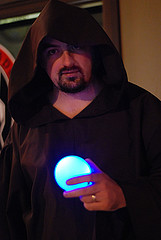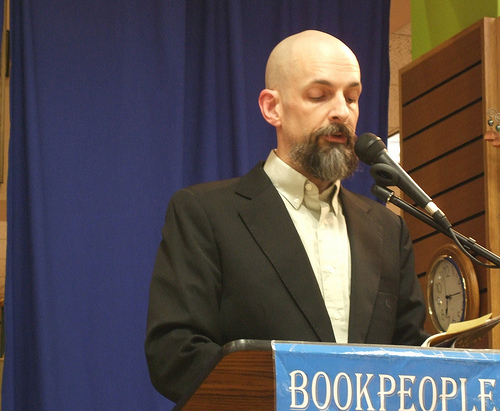Stephenson Post CyberPunk
By EricMesa
- 8 minutes read - 1595 wordsI read somewhere, maybe even Wikipedia, that the reason Bud dies so early in the The Diamond Age is that his character represents a stereotypical cyber-punk character and Stephenson is signaling that cyber-punk is over - this work of fiction is going beyond that. Stephenson then does a 90 degree turn genre-wise and does a historical fiction with Cryptonomicon. And he deepens that with The Baroque Cycle. Recently I read Anathem, a more typical science fiction novel in that it ostensibly involves aliens instead of a future Earth. Yet the steady stream that unites all of these books as Stephenson titles is the constant exploration of technology and its effects on society. It doesn’t matter whether that takes place in the future, during World War 2, or on another planet.
Sometime in the past five years I learned what science fiction was truly about. Science fiction isn’t really about cool technology, aliens, or even the future. Science fiction is a way to deal with today’s problems by projecting them into another time and place. This lets the author explore topics such as racism, sexism, the human-technology interface, genetic engineering, and dozens of other topics without people getting caught up their feelings about their world. Although this is overly simplistic, it is conceivable that someone who was deeply racist could see the error of his ways when he sees humanity suffer similarly under alien hands.
[caption id=“attachment_3400” align=“alignleft” width=“161” caption=“Erasmas, the protagonist of Anathem (photo by Lisa Brewster - used under Creative Commons license)”]  [/caption]
[/caption]
In Anathem Stephenson takes this idea of science fiction as mirror of society and turns the setting up to 11. The setting is Earth as it may have been if monasteries were not cloisters for the religious, but for the scientifically-minded. The history of the planet even includes a Roman Empire clone - the Bazian Empire. Where our history has monasteries jump-starting The Enlightenment by having kept copies of books from antiquity, Arbre’s history has the monasteries first serve as a sort of university system and then as a sort of prison for the intelligent. In a way, it is the extension of our current fear of intelligence in the West. For the past few election cycles we’ve seen people lambasted for being too smart. People inherently distrust what they can’t understand - you see it all the time with computers and with complaints about how people used to be able to get under the hood of a car and figure out what’s going on. So, when the scientists in Anathem became too powerful, they were forced to live in seclusion in their maths, as the monasteries are called. And when they again cause a scare by creating weapons even more powerful than nuclear weapons, The Everything Killers, they are forbidden from working with computers. So they learn to cope with technology restrictions, writing their mathematical texts on leaves.
In order to both keep them from having too much influence on society and from collaborating with each other, a system is set up so that the gates of the maths are only opened once per year for those doing basic science, once every 10 for the next group, 100 for the next, and 1000 for the most intelligent. At this time they invite people from the surrounding cities to visit and enroll their children. It also serves to allow the city to see that the math isn’t up to no good. After all, while the government nominally provides protection for the maths, if it is convenient for them to do so, they allow the citizens to sack the maths. The story deals with Erasmas, a member of one of these maths. At first it simply describes his life in the math and his first time outside the gates since joining as a child. Then the real plot sets in.
The book has its own terminology for things, smart phones are jeejahs, for example. On the whole, it is not too bad. Clockwork Orange, in comparison, was absolutely dreadful to read because I hardly ever knew what the heck was going on because of all the impenetrable slang. This wasn’t a problem with Anathem for two reasons. First of all, Stephenson typically does a good job of describing what the items do so that it’s very quickly clear that a speely is a movie. Second, this terminology allows him to get around our preconceptions. If he said smart phone instead of jeejah, we’d probably think of the one we have and what it’s capable of and what it looks like. With his own terminology we learn that it’s analogous to a smart phone, but don’t get caught up in the details of whether it does this or that. It also serves a purpose in the book in that some of the older members of the math that haven’t been out in decades are also clueless about what the item does and often the word they remember is that same word we’d use on Earth. He also has another category of terminology in the book where he takes words as we use them and then uses a wink and a nod to give them a slightly different meaning in the book. Here’s a good example:
Bulshytt: (1) In Fluccish of the late Praxic Age and early Reconstitution, a derogatory term for false speech in general, esp. knowing and deliberate falsehood or obfuscation. (2) In Orth, a more technical and clinical term denoting speech (typically but not necessarily commercial or political) that employs euphemism, convenient vagueness, numbing repetition, and other such rhetorical subter¬fuges to create the impression that something has been said. (3) According to the Knights of Saunt Halikaarn, a radical order of the 2nd Millennium A.R., all speech and writings of the ancient Sphen¬ics; the Mystagogues of the Old Mathic Age; Praxic Age commercial and political institutions; and, since the Reconstitution, anyone they deemed to have been infected by Procian thinking.
and here’s another good one:
Saunt: (1) In New Orth, a term of veneration applied to great thinkers, almost always posthumously. Note: this word was accepted only in the Millennial Orth Convox of A.R. 3000. Prior to then it was considered a misspelling of Savant. In stone, where only upper-case letters are used, this is rendered SAVANT (or ST. if the stonecarver is running out of space). During the decline of standards in the decades that followed the Third Sack, a confusion between the letters U and V grew commonplace (the “lazy stonecarver problem”), and many began to mistake the word for SAUANT. This soon degenerated to saunt (now accepted) and even sant (still deprecated). In written form, St. may be used as an abbreviation for any of these. Within some traditional orders it is still pronounced “Savant” and obviously the same is probably true among Millenarians.
This ranges from cute to clever to obnoxious. I found the use of Saunt to be somewhere between cute and clever especially how it’s abbreviated to St, as in Saint - which draws in the comparison of a math to a monastery. The bullshytt one was hilarious, especially the way it was used in the book. He also has fun with the convention that Asian monks invented Kung Fu by having the equivalent development take place with the study of Vale Lore (valore) which is the stand-in for Kung Fu in this world.
[caption id=“attachment_3398” align=“aligncenter” width=“500” caption=“Monks involved in Shovel-fu (photo by ToastyKen used under Creative Commons license)”]  [/caption]
[/caption]
Like most of his books, Anathem contains long passages of technical detail. In this book, a lot of it consists of Dialogs, philosopher-like exchanges between members of the maths, and, as such, are entertaining and often further the story. However, as in most of his books, this information is awesome in its detail and content, but can sometimes seem to stop the story. Most of the time I really, really enjoyed it. A few times, especially as the story neared the climax, I found myself getting a little impatient as I wanted the story to continue so I could find out what exactly was going on.
Unlike most of his books, Anathem has a proper conclusion. The previous books I read all seemed to end immediately after the climax. It’s as though Stephenson said, “well, the tying up of the loose ends is often very boring and we already know that that good guys won (or lost) so, why bother?” But it often left me unsatisfied because I wanted to know, now that things had returned to normal (or a new equilibrium), what the characters were going to do. So, whether or not this sticks in future books, I feel like Stephenson has grown enough as a writer to get through writing those post-climax parts of the book and finish up the story he set out to tell.
There’s really so much more to talk about, but I like this book so much, I’d prefer not to have any spoilers. Everything about how he lays out the world and history of Arbre and how it is similar to and diverges from ours is delightful to read. And I really don’t want to spoil the main conflict or the first quarter or so of the book is ruined if you’re not in the dark as much as the main characters.
If Anathem isn’t Neal Stephenson’s Magnum Opus, I can’t wait to see how he tops this book.
[caption id=“attachment_3399” align=“aligncenter” width=“500” caption=“Neal Stephenson (photo by John of Austin used under a Creative Commons license)”]  [/caption]
[/caption]